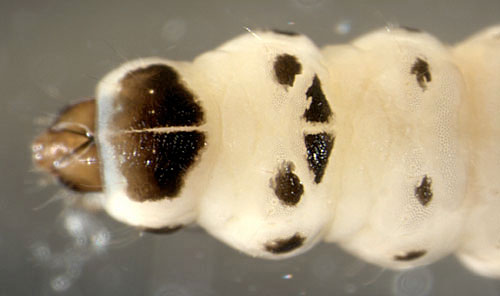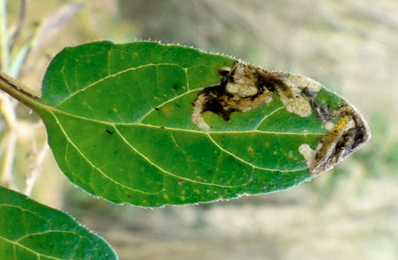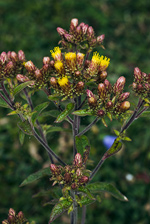|
||||||
|
INULA. Ploughman's-spikenard, Golden-samphire and Irish Fleabane. [Asteraceae] |
|
|
Ten species of Inula are recorded in Britain. These included the native Ploughman's-spikenard (I. conyzae), Golden-samphire (I. crithmoides) and Irish Fleabane (I. salicina). The BSBI provide a downloadable plant crib for Inula / Digitalis rosettes, which can appear very similar. Nine British miners are recorded on Inula. A key to the European miners recorded on Inula is provided in Bladmineerders van Europa. The agromyzid Melanagromyza eupatorii bores the stems of Inula in Britain and elsewhere. Elsewhere the agromyzid Napomyzxa lateralis is recorded boring stems of Inula. |
|
Key for the identification of the known mines of British |
Note: Diptera larvae may live in a corridor mine, a corridor-blotch mine, or a blotch mine, but never in a case, a rolled or folded leaf, a tentiform mine or sandwiched between two more or less circular leaf sections in later instars. Pupation never in a cocoon. All mining Diptera larvae are leg-less maggots without a head capsule (see examples). They never have thoracic or abdominal legs. They do not have chewing mouthparts, although they do have a characteristic cephalo-pharyngeal skeleton (see examples), usually visible internally through the body wall. The larvae lie on their sides within the mine and use their pick-like mouthparts to feed on plant tissue. In some corridor miners frass may lie in two rows on alternate sides of the mine. In order to vacate the mine the fully grown larva cuts an exit slit, which is usually semi-circular (see Liriomyza huidobrensis video). The pupa is formed within the hardened last larval skin or puparium and as a result sheaths enclosing head appendages, wings and legs are not visible externally (see examples). See Key to non-Diptera. |
1a > Leaf-miner: Mine linear, whitish, both upper and lower surface. Pupation internal, at the end of the mine with the anterior spiracles projecting through the epidermis (Spencer, 1976: 433). Upper-surface, less often lower-surface corridor. Frass in isolated grains. Pupation within the mine, usually in a lower-surface puparial chamber. A long whitish upper surface corridor, which eventually goes lower surface. |
|
Chromatomyia
horticola (Goureau, 1851) [Diptera: Agromyzidae] |
1b > Leaf miner: An irregularly linear mine which can be both on the upper and lower leaf surface. Pupation takes place either at the end of the mine in an exit slit cut in the leaf or on the ground (Spencer, 1972b: 70 (fig. 226), 73; Spencer, 1976: 407 (fig. 712), 408). Upper surface corridor, often following the midrib for some distance. Frequently the very first part of the mine is lower-surface, and sometimes the entire mine remains at the lower surface. The corridor is wide from the start, with irregular sides. Frass initially in two rows of fine grains; further on the grains become larger and more irregular, sometimes forming pearl chains, and are dispersed less regularly. Pupation takes place either outside or within the mine. When the larva has left the mine a semicircular exit slit is made. When the puparium is formed within the mine the spiracles do not penetrate the epidermis, and an irregular semicircular opening is made in the epidermis in front of the puparium. Mines down the leaf from the tip, then doubles back and then mines towards the apex, often doubling back a second time, towards the leaf base. |
|
Phytomyza conyzae Hendel, 1920 [Diptera: Agromyzidae]. |
1c > Leaf-miner: A distinctive mine primarily above mid-rib, with irregular short lateral offshoots into leaf blade. Pupation external (Spencer, 1972: 51 (fig. 172), 55; Spencer, 1976: 270, 271 (fig. 486)). Branched, whitish, upper-surface corridor; main axis overlying the midrib; side branches overlying the main lateral veins. (In Campanula and Phyteuma the mine is much less branched, sometimes nothing more than a corridor on top of the midrib). Frass in rather long strings. Usually the mines begins as a long and narrow, shallow, tortuous lower-surface corridor that ends upon the midrib but otherwise is not associated with the leaf venation. Often this initial corridor is filled with callus, and then even less conspicuous. Pupation outside the mine. A linear mine on the upper surface, usually following the midrib and showing side branches along the veins. The frass is in strings. |
|
Liriomyza strigata (Meigen, 1830) [Diptera: Agromyzidae]. |
|
Key for the identification of the known mines of British |
Note: The larvae of mining Coleoptera, Hymenoptera and Lepidoptera may live in a corridor mine, a corridor-blotch mine, a blotch mine, a case, a rolled or folded leaf, a tentiform mine or sandwiched between two more or less circular leaf sections in later instars. Larva may pupate in a silk cocoon. The larva may have six legs (although they may be reduced or absent), a head capsule and chewing mouthparts with opposable mandibles (see video of a gracillarid larva feeding). Larvae of Hymenoptera and Lepidoptera usually also have abdominal legs (see examples). Frass, if present, never in two rows. Unless feeding externally from within a case the larva usually vacates the mine by chewing an exit hole. Pupa with visible head appendages, wings and legs which lie in sheaths (see examples). |
1a >Leaf-miner and case-bearer: |
1b > Leaf miner |
2a > Leaf-miner and case-bearer: The larva makes at least two cases and leaves the empty case by the cut out leaf section. The early cases are compressed with keels, dorsally and laterally. Later cases are more tubular and hairy (from the hairy leaves, used to make the case). Larva in a spathulate leaf case. It is 10-12 mm long, straght, brown, tubular, patently hairy (depending on the hostplant), bivalved. The mouth angle is rather variable, usually around 45°. An unusual character of this species is that after each moult the larva makes a new case; the old, vacated case is left at the place where the new one is made, at the leaf margin. |
|
Coleophora conyzae Zeller, 1868 [Lepidoptera: Coleophoridae]. |
2b > Leaf-miner and case-bearer: Larva mines leaves. On Eupatorium the case is extended at the anal end by adding silk and widened by cutting a ventral gusset. On Inula the case is firstly extended by adding rings of leaf-cuticle at the oral end, before reverting to the method used when on Eupatorium. The full-grown case is 10 mm long. A slender tubular silken case, about 10 mm long, straw coloured, three valved. Mouth angle about 30°. |
 Coleophora folicularis larva, dorsal Image: © Willem Ellis (Bladmineerders van Europa) |
|
Coleophora follicularis (Vallot, 1802) [Lepidoptera: Coleophoridae]. |
| 2c > Leaf-miner and case-bearer: The larva builds a 'pistol case'. The mature case is around 15mm long with a slightly swollen middle region, being palest at the anal end. Larva in a slender tubular silken case. The case is about 15 mm long, yellow-grey, and trivalved. The mouth angle is about 0°-10°, causing the case to lie flat on the leaf. |
|
Coleophora inulae Wocke, 1877 [Lepidoptera: Coleophoridae]. |
3a > Leaf-miner: Mines the lower leaves, making them hollow. The mine is along the midrib and broadens into a blotch. One or several broad corridors, radiating from the leaf base, often along the midrib, towards the leaf tip widening into a roundish blotch, not containng any frass. The larva, that seems to feed only at night, retreats during feeding pauses in the leaf base and is invisible then. Often two larvae in a mine. Pupation in a little separate mine (pupal chamber). |
|
|
|
Digitivalva perlepidella (Stainton, 1849) [Lepidoptera: Acrolepiidae]. |
3c > Leaf-miner: Rather narrow corridor, untidy and sometimes branched, starting from the base of the leaf, in particular the midrib. Sides of the corridor irregularly eaten out, not really parallel. Frass mostly present, and then in a central line. The larva is capable of leaving the mine and start a new one elsewhere. These later mines are much broader, and the frass is scattered irregularly.. |
 Mine of Orthochaetes insignis on Prunella vulgaris Image: © Jean-Yves Baugnée (Bladmineerders van Europa) |
|
Orthochaetes insignis (Aube, 1863) [Coleoptera: Curculionidae]. |
| Last updated 05-Jul-2019 Brian Pitkin | ||

